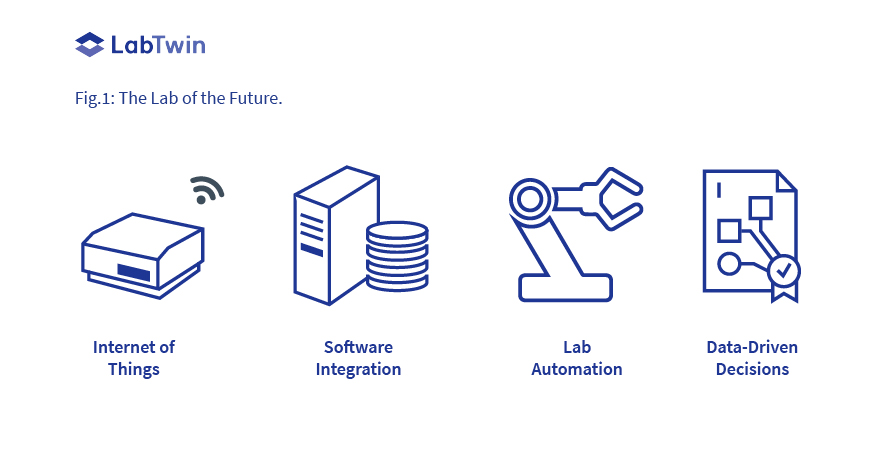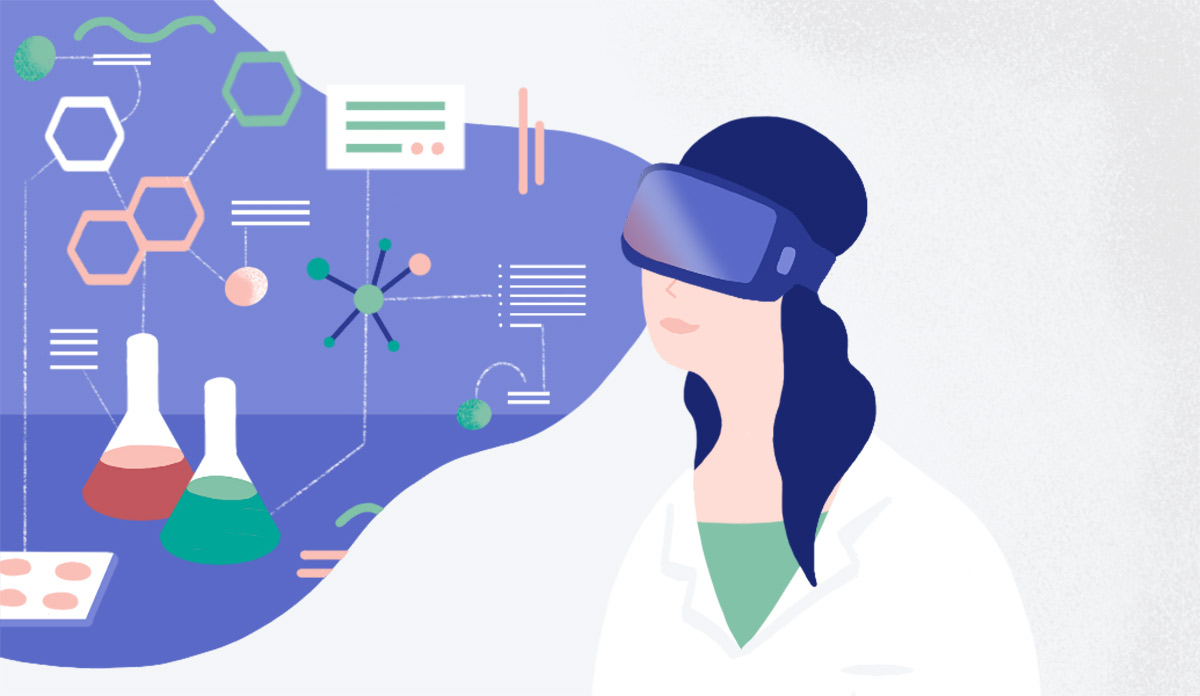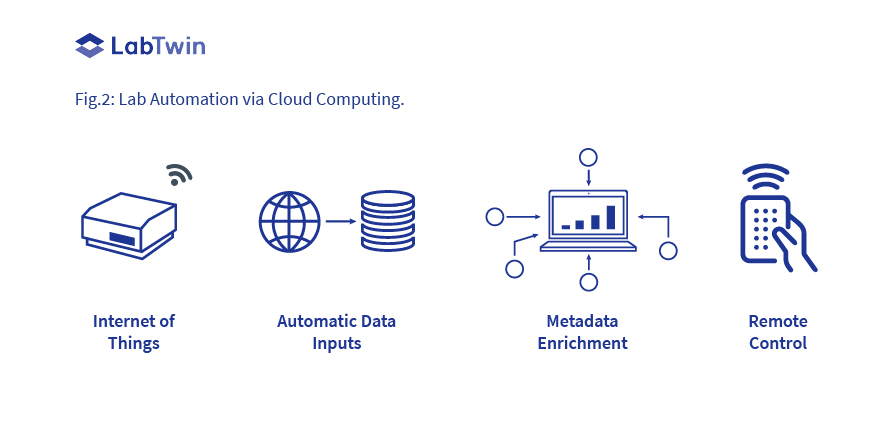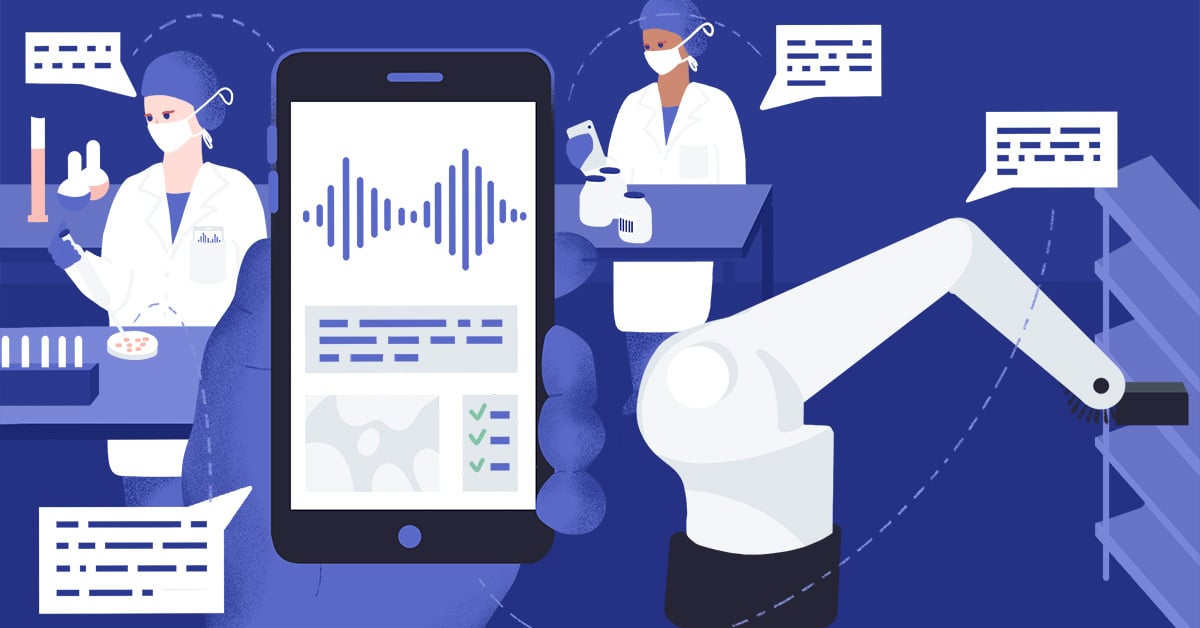The Fourth Industrial Revolution or Industry 4.0 is characterized by a fusion of the digital, biological, and physical worlds. The main feature of this revolution has been an increased incorporation of new technologies featuring lab digitization and lab automation into the workflow. As an ecosystem, the life sciences research laboratory had previously shielded itself from meaningful lab digitization and lab automation. But as it is gradually evolving into a smart lab of the future, we are witnessing an interlinking of the physical and digital worlds in the research laboratory.
Challenges to the Lab of the Future
Technology associated with today’s research laboratory faces a multitude of challenges, primarily related to digital lab transformation and lab automation. These challenges are hurdles in the realization of the smart lab of the future.
1. Challenge with Integration
Though newer technologies are being introduced into the life sciences research laboratory, true lab digitization is lacking mainly because the technology used has been designed in silo without considering the needs of the end user. Researchers only hear about these products when they are finalized and ready to sell. This results in a disconnect that prevents efficient integration, leading to low adoption by the end user and a stalled transition to the lab of the future. This product-centred design approach has resulted in an unmet need in the lab.
2. Data Management Challenge
Researchers have to work with disconnected technologies that may not be compatible with each other, thereby producing data in different formats. As a result, researchers end up working with data from myriad sources that need manually input into paper lab books or static software such as Electronic Laboratory Notebooks (ELNs). Data management challenges further are compounded due to decades-worth of fragmented, isolated datasets. The lack of effective data management has resulted in data silos, which present hurdles in collaborative data sharing, analyses and application.
3. New Skill Sets for Lab Automation
Lab automation is another key element in the evolution into smart lab of the future. Some of its challenges involve high associated costs, developing new skills, and learning how to use new sophisticated software to manage automation.

The Solution
Seamless Digital Transformation
In order for digital transformation to succeed, it is important to incorporate user needs into its design and development. This so-called empathic innovation or user-centred innovation can facilitate integration of the resulting technology into the workflow of the lab. ELN and laboratory information management systems (LIMS) are examples of digitization, both of which have remained woefully disconnected necessitating manual and hands-on approaches. Disrupting this space with an out-of-the-box approach is needed to revolutionize the field. One such solution to improve on the ELN is through development of a voice-powered digital lab assistant. As an early and leading developer in this field, LabTwin is a pioneer that is making information accessible, data reproducible, and research more efficient by user-centred design principles. LabTwin’s voice-powered digital lab assistant, the first of its kind, will not only improve efficiency and reduce errors but will also do so at lower economic costs to the researcher. By enabling lab digitization, LabTwin is poised to be a major player in developing the smart lab of the future.
Newer Aspects of Lab Digitization
Beyond the basic concept have emerged novel aspects of lab digitization, such as augmented reality (AR), artificial intelligence (AI), robotics, quantum computing, and internet of things (IoT). These are valuable additions to the future lab of the future assisting in a wide range of tasks. It has the potential to affect digital transformation.
AR technology can digitally overlay information on the physical setup, can facilitate data visualization, and can also help understand equipment functioning. Integrating AR with ELN or LIMS may be an important step in transitioning towards a true smart lab of the future.

As a new emerging technological advance, AI is important in data analyses as it can identify patterns in unstructured data and facilitate analyses. AI can recognize complex patterns, process information, draw conclusions, and make recommendations.
IoT is a system of connected devices and machines linked to the internet, with the goal of providing a functionality that can be explored to transition to a smart lab. In the context of life sciences labs, IoT, known as Internet of Laboratory Things (IoLT), connects devices and equipment across the laboratory landscape. The total market for IoLT (healthcare and pharmaceutical/biotechnology) is anticipated to be in the range of $150 billion by 2025.
Integrating data streams from AR, AI, and IoT into the data management ecosystem is critical to seamless integration into the operational components of the lab of the future. This will facilitate optimal utilization of technologies allowing scientists to work more efficiently and spend more time on research.
Data Management
Efficient data management infrastructure is an important aspect of successful digitization. There are a multitude of current and emerging tools for digital recording and management of lab data, such as ELN, LIMS, lab execution system (LES), document management system (DES), and voice-powered digital lab assistants. Data systems need to be set up in ways that will enable researchers to record data with high fidelity, and make this data easily accessible and shareable. Cloud storage is an emerging platform in this space that will be useful in preventing data silos and enable researchers to collaborate from geographically or physically distant locations. This in turn will allow the lab of the future to develop into an efficient global collaboration. In addition, close attention must be paid to data storage, integrity and security, quality control, decision making, and analytics.
Lab Automation
Lab automation over the past few decades was restricted to high-throughput screening robots. However, recent automation technology is modernizing the research milieu, particularly through advances in AI and IoT. Based on current trends, one can predict that the lab of the future will likely witness steadily increased application of lab automation. This can range from the “trivial” day-to-day research activities to more advanced features such as automation of the entire experimental workflows and even subsequent data analyses.
One peer-reviewed study has shown that lab automation can reduce manual errors by 50%, and increase productivity by as much as 75%. Additionally, automation can reduce reagent wastage by 25%.

Voice-Powered Digital Assistant
Voice-powered digital assistants that can “talk” to lab equipment will serve as a means of communication between scientists and their lab technology. This would provide scientists the ability to control lab equipment, and set up and run experiments using voice commands, either from the laboratory or even from remote locations. A well-integrated smart digital assistant such as the one from LabTwin will at some point in the near future enable recording experimental details by extracting this information from lab machines. Additionally, this information will also be fed to it through voice commands. Most importantly, voice-powered devices are on the path to facilitating data management by recording experimental data, retrieving previously recorded data for analyses, and possibly even presenting analysed data.
Advantages of Digital Transformation and Lab Automation
The benefits of integrating lab digitization and automation into the current research laboratory framework are primarily 3-fold:
a) Accelerated innovation:
> Increase in productivity and research efficiency through effective data management, collaborative data sharing, and data analyses.
> Scientists can have real-time access to accurate, updated data and scientific information from online resources.
b) Enhanced security: There is increased security since digitization protects data and other recorded information from physical threats. In addition, the digital files can be tracked to monitor accessibility.
c) Cost effectiveness: This technology will prove to be more cost-effective, due at least in part to reduced errors with increased reproducibility, and also fewer hands-on hours.
“We founded LabTwin because, after working directly with scientists for over ten years, I saw a real need for better automation, data access and capture while working at the bench. It is difficult and time-consuming for scientists to manually look up information or document all of the details required when they are working on four to five experiments at a time. LabTwin’s digital assistant leverages AI and voice-recognition technology to minimize errors, streamline productivity and improve reproducibility of scientific discoveries.”
Steffen Gloth
Co-Founder and Head of Operations, LabTwin
Conclusion
Rapid technological advances have allowed increasing lab digitization and lab automation in the research setting. Though obstacles still remain in integrating lab digitization with automation, their subsequent implementation will usher in the lab of the future. This has the potential to benefit all stakeholders by exponentially moving research forward. The life sciences research laboratory is on the brink of a revolution that will lead to a smart lab of the future.
Contact us to learn how LabTwin’s voice-powered digital lab assistant can help you improve productivity and accelerate R&D.



